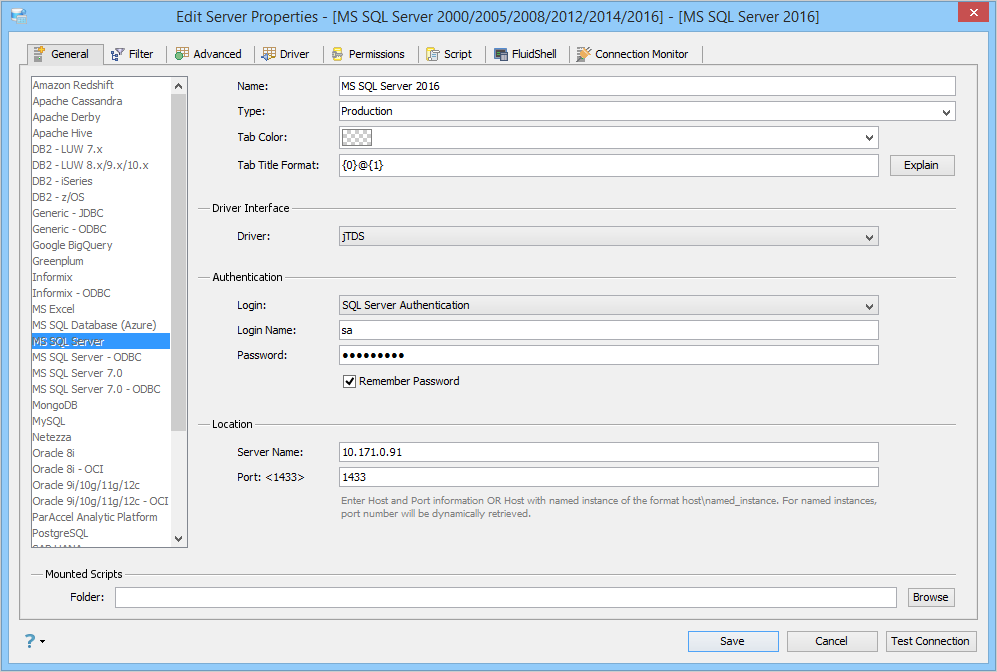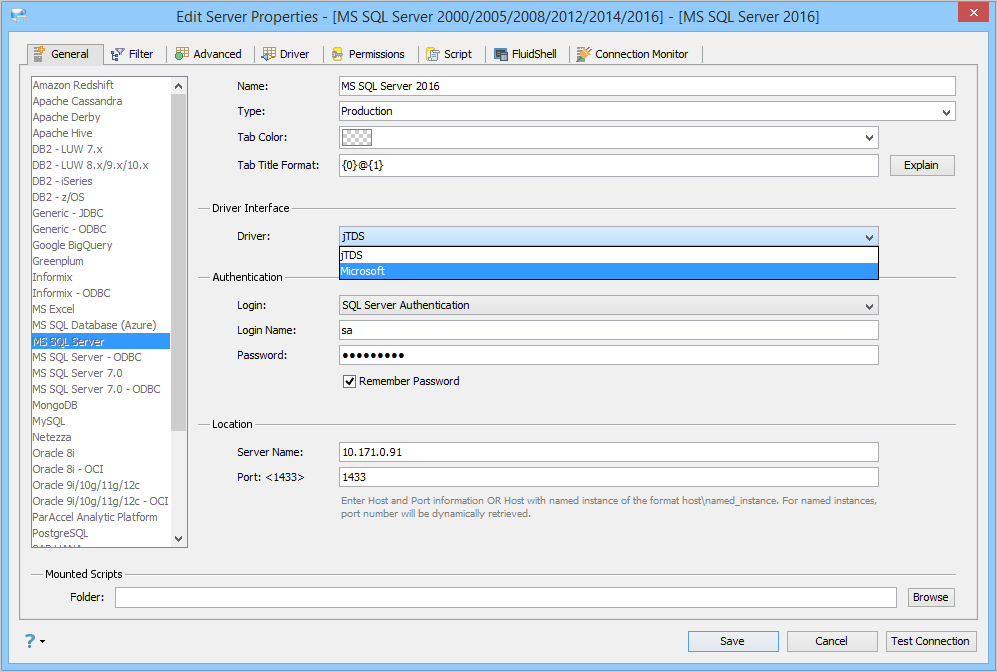Page History
...
| Info |
|---|
| Using the Keyboard combination "CTRL + SHIFT + P", you may quickly access Server Properties and edit Tab Coloring options. |
Driver Interface
From the Driver drop-down list, choose the driver using which you want to connect to the server. You can choose jTDS or Microsoft JDBC driver and view its details in the Driver tab.
| Warning |
|---|
Microsoft JDBC Driver has some known limitations. Before proceeding with this driver, ensure you have read the following:
|
...
Step 3: If you receive the following warning:
Ensure that you've included the path to your USER_HOME directory within the datastudio.ini file as detailed within the bottom of the section "Troubleshooting Missing Connections on Windows".
| Anchor | ||||
|---|---|---|---|---|
|
The Advanced Tab requires entering Domain, Username, and Password when connecting to SQL Server 2005 for debugging. If your SQL Server is not part of a domain, enter its IP address as the domain.
...
- You can create a local user under "Users" group.
- Then go to Control Panel > Administrative Tools > Local Security Policy > Security Settings > Local Policies > Security Options :-
- Double-click "DCOM: Machine Access Restrictions" policy, click Edit Security, add the user-created above, allow "Remote Access"
- Double-click "DCOM: Machine Launch Restrictions" policy, click Edit Security, add the user-created above, allow "Local Launch", "Remote Launch", "Local Activation", "Remote Activation"
- Double-click "Network Access: Sharing and Security Model for local accounts" policy, and set to Classic"
- Go to Control Panel > Administrative Tools > Component Services > Computers > right-click My Computer > click Properties > click COM Security tab :-
- In Access Permissions section, click Edit Default > add the user-created above, allow "Remote Access"
- In Launch and Activation Permissions section > click Edit Default > add the user created above, allow "Local Launch", "Remote Launch", "Local Activation", "Remote Activation"
- Disable Windows Firewall or any other Firewall software that would prevent DCOM clients from connecting to the DCOM server.
(You can also go to a specific component in the Component Services section to grant permission, instead of granting permission from "My Computer" which is a blanket grant)
| Anchor | ||||
|---|---|---|---|---|
|
Edit the Server Properties, to use FILTER options for a Server in Aqua Data Studio:
...
| Info |
|---|
| Using the drop-down at the top of the Filter Tab, quickly change your Schema or Folder View. |
Filter Examples:
If your intention is to show only the tables that start with XXPKD, then you need to change your main filter to "Exclude All", and secondary filter to "+XXPKD*". Note the "+" in front of the XXPKD pattern. Also, note that the filter pattern is case sensitive.
The filter shown below is set to exclude all databases except those that start with "aq". This is similar to the above example where all schemas, except the XXPKD schema, are excluded. Then, there is an "Object Folder" filter on the Tables folder, which excludes everything except those that start with "forum".
| Anchor | ||||
|---|---|---|---|---|
|
Edit the Server Properties to use Advanced Properties in Aqua Data Studio:
...
- Transaction Isolation Level: Support for setting Transaction Isolation Level
- TRANSACTION_NONE - A constant indicating that transactions are not supported.
- TRANSACTION_READ_COMMITTED - A constant indicating that dirty reads are prevented; non-repeatable reads and phantom reads can occur.
- TRANSACTION_READ_UNCOMMITTED - A constant indicating that dirty reads, non-repeatable reads, and phantom reads can occur.
- TRANSACTION_REPEATABLE_READ - A constant indicating that dirty reads and non-repeatable reads are prevented; phantom reads can occur.
- TRANSACTION_SERIALIZABLE - A constant indicating that dirty reads, non-repeatable reads, and phantom reads are prevented. - JDBC Escape Processing: Allows JDBC driver to perform escape sequence before sending the SQL code to the server.
- Display System Folders: Allows to show/hide System Tables in Tables.
- Always Display Column Name in Results: Allows to show/hide column names in query results.
- Enable DB Filters for Query Window: Enables/Disables db filters for query windows using this connection.
- Only display databases that user has access to: Displays only the databases the current user (from the Login Name on the General tab) has access to within the schema browser.
- Set quoted_identifier: Causes connection to follow the SQL-92 rules regarding quotation mark delimiting identifiers and literal strings.
- Set ansi_nulls: Causes connection to follow SQL-92 compliant behavior of the Equals (=) and Not Equal to (<>) comparison operators when used with null values.
- Set ansi_null_dflt_on: Causes connection behavior to override default nullability of new columns when the ANSI null default option for the database is false.
- Set ansi_padding: Changes connection behavior in the way the column stores values shorter than the defined size of the column, and the way the column stores values that have trailing blanks in char, varchar, binary, and varbinary data.
- Set ansi_warnings: Specifies SQL-92 standard behavior for several error conditions.
- Fetch Size: Determines the Fetch Size (number of rows physically retrieved from the database at one time by the JDBC driver).
- Connections Pooled: Enables connection pooling. Read more about connection pooling here.
- Force Auto-Commit: When this option is selected, it sets auto-commit to TRUE for any Query Window to this server and disables the icons on the toolbar, regardless of the option in File > Options > Query Analyzer > [DATABASE] > [Auto Commit].
- Data Warehouse Mode: Read Only or Read/Write
- Object Folder Display: [Default], [Name], [Schema].[Name] or [Name]([Schema]) sets how the Schemas will be displayed.
- Object Folder Schema Folder Grouping: Default, Yes or No. Schema Folder Grouping makes finding tables much easier because it groups them instead of showing each object individually.
- Debugger Domain: Allows you to specify the domain name of the server hosting the SQL Server. If your SQL Server is not part of a domain, enter its IP address as the domain.
- Debugger User: Allows you to specify the user name of the server hosting the SQL Server.
- Debugger Password: Allows you to specify the password of the server hosting the SQL Server.
Debugger (see the section above "Connecting and Use with MS SQL Server Debugger")
| Info |
|---|
| Using the drop-down at the bottom of the Advanced Tab, quickly change your Object Display in the Server Browser. |
...
| Anchor | ||||
|---|---|---|---|---|
|
Edit the Drivers Properties to use Driver Parameters in Aqua Data Studio:
...
- Driver: This displays the JDBC driver used for this connection.
- Driver Parameters: This option is to allow a user to specify extra JDBC parameters that a user might want to use in establishing a connection.
- Connection URL: This displays the connection URL for this server connection.
- Driver Parameters Quick filter: This option is to allow a user to search JDBC parameters that a user might want to use in establishing a connection.
| Anchor | ||||
|---|---|---|---|---|
|
Edit the Permissions in Server Properties in Aqua Data Studio:
...
- Control Statement execution and Properties of the Query Analyzer, Table Data Editor, and Visual Editing.
- Grant / Revoke Permissions easily for executing DDL and DML Statements in the Query Analyzer.
- Change the behavior of the Table Data Editor for manipulating rows in Tables.
- Grant / Revoke Alters, Creates, Drops and View Properties of Visual Editing Tools.
- Allow SQL debugging for this server connection.
...
| Anchor | ||||
|---|---|---|---|---|
|
Edit Scripts in Server Properties in Aqua Data Studio:
...
- Enter an SQL script that is executed each time a new connection is established.
- This allows the user to SET connection settings for a server connection. (eg: SET ROLE, ALTER SESSION SET XXX)
...
| Anchor | ||||
|---|---|---|---|---|
|
Edit Shell Scripts in Server Properties in Aqua Data Studio:
...
- Enter a FluidShell script that is executed each time a new FluidShell connection is established.
- This allows the user to cd (change directory) for a server connection. (eg: cd /scripts)
...
| Anchor | ||||
|---|---|---|---|---|
|
Configuring SQL Express and connecting with Aqua Data Studio.
...
1. Launching ’SQL Server Surface Area Configuration’ tool: First step is to launch the SQL Server surface area configuration tool that is installed with SQL Server Express.
REMOTE SURFACE AREA CONFIGURATION
2. Configuring TCP/IP Remote Connections: Select ’Surface Area Configuration and Services and Connections’ option and then select ’Remote Connections’ in the tree browser. Choose the ’Using TCP/IP Only’ or ’Using both TCP/IP and named pipes’, the click on ’Ok’ or ’Apply’.
REGISTER SERVER
...
The MS SQL Server Debugger works with MS SQL Server 2005 Express just as it does for MS SQL Server 2005. Click here for more information on how to register a server for debugging with the MS SQL Server Debugger.
| Anchor | ||||
|---|---|---|---|---|
|
Configuring MSDE and connecting with Aqua Data Studio.
...
As described in the MSDE installation docs: Setup Parameters
Installation docs: MSDE Installation Instructions
MSDE SupeSocketNetLib Registry
MSDE TCP Registry
...
To verify that your MSDE installation has remote connections enabled you may run "regedit" to view your registry settings. Verify the following keys ...
HKEY_LOCAL_MACHINE\SOFTWARE\Microsoft\Microsoft SQL Server\
MSDE\MSSQLServer\SuperSocketNetLib\ProtocolList=[tcp np]
HKEY_LOCAL_MACHINE\SOFTWARE\Microsoft\Microsoft SQL Server\
MSDE\MSSQLServer\SuperSocketNetLib\Tcp\TcpPort=[Port]
Registration - SQL Server
3. Register Connections: Now, register a server connection in Aqua Data Studio using ’Hostname\SQLEXPRESS’ as the hostname parameter, where Hostname is the hostname or ip IP address of the SQL Server and SQLEXPRESS is the instance name.
| Anchor | ||||
|---|---|---|---|---|
|
Enable the connection monitor to start an application thread that monitors the status of the connection associated with the Query Window.
With the connection monitor, you can:
...
For more information, see Connection Monitor.

















